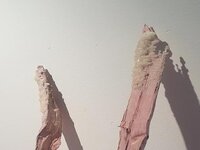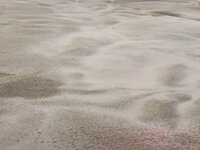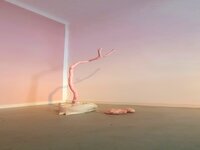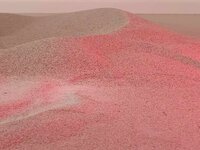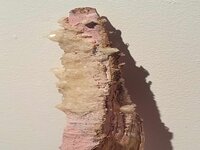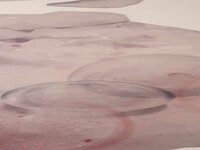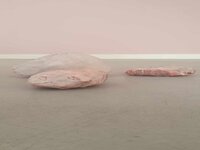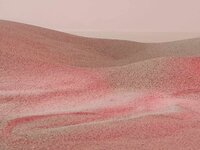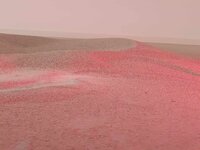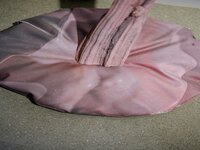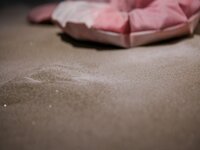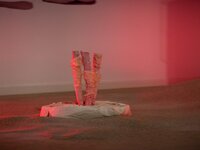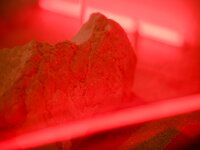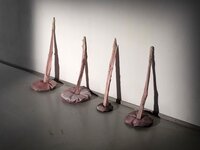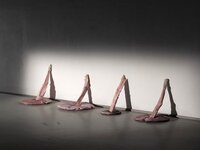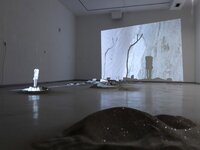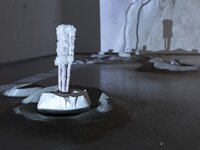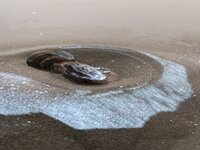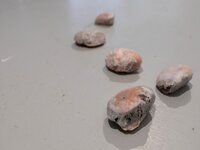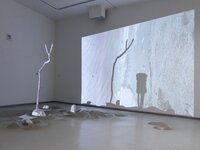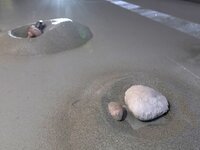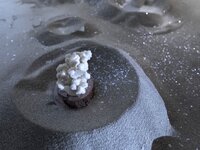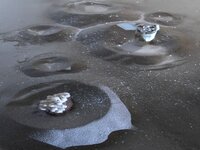Gallery of Floating Archipelagos
Karas Gallery, Zagreb, Croatia, 2023
Mavena Gallery, Split, Croatia, 2023
Since the summer of 2022, Martina Miholid has been dedicated to developing a series of spatial installations exhibited in solo1 and group exhibitions.2 The works created in specific gallery and museum contexts suggest a strange, dystopian environment of unnamed islands, archipelagos and reefs, composed of organic formations, found objects, digital prints, photographs, foils, lighting fixtures and other elements characteristic of the artist’s aesthetics. A departure from her usual poetics is evoked by a gloomier atmosphere, reflected primarily in a prevailing darker spectrum of colours.
One of the narrative backbones of the series of works, which, however, is not literally staged in the exhibitions, is Hans Christian Andersen's famous fairy tale “The Little Mermaid“. The story of a tragic character who sacrifices her greatest virtue, her voice, and then her body, and even her existence, is an ideal reference to the contemporary imperative of constant adaptation of female appearance to the imposed canons of beauty. The body changed by cosmetics, surgery and exercise continues its further transformation in the digital and viral reality, which perpetuates further imperatives of artificial and unnecessary ideals.
Dealing with the search for an archetype of beauty that emanates complex issues such as social coercion and commercial exploitation at its core, Martina does not offer a one-sided critical determination. Namely, the manipulation of physical appearance is accompanied by metaphors of metamorphosis, transition and fluidity of identity. Such an interpretation is revealed in the analysis of the Little Mermaid's genealogy. Her ancestors are creatures from Greek mythology and Homer's epic “Odyssey“. In the latter, we find an episode with the sirens who, because Odysseus escaped the deadly call of their seductive song, return to the sea out of despair. Unlike the usual idea of a body with a fish tail instead of legs, they had bird bodies. The reason for their downfall, as in the case of the mermaid in the nineteenth-century fairy tale, is the inability to express themselves with their voice. They did not lose it, but the inability to reach Odysseus is equal to annihilation, which becomes the siren's fate.
The antipode of such an unfortunate and ultimately passive situation is the one embodied by Inana, the Sumerian goddess of sexual love, fertility and war, called Ishtar in Babylonian mythology, and in later cultures was transposed into Aphrodite, Venus, Freya, or Lada, the goddess of spring, love and beauty in old Slavic mythology. She was the thematic and conceptual thread of the eponymous exhibition, which Martina realized with a group of artists in 2019 at the Baeva Gallery.3
Ishtar, or the queen of the night, was depicted as a naked woman with an idealized body, with large wings and long legs that have bird claws instead of feet. Parthenope, one of the three siren sisters who tried to lure Odysseus to his death, was similarly portrayed on reliefs. Ishtar, on the other hand, transcended her death, and among her many powers, she was known for the ability to assign gender. Some members of the cult of the goddess supposedly changed their gender from male to female, indicating that in the state religion of Babylon gender was perceived as changeable. This fluidity in seeking new forms and meanings complements the aforementioned aspiration for transformation, opening up questions of freedom and strength in the search for one's own voice and identity. The dynamics and tension of the variety of individual and universal, momentary and eternal transformations are ideally supported by the contrast between the defined nature of material objects and the abstraction of organic creations. They emanate different symbolisms, for example, water represents the source of life, and islands are the "primordial spiritual centre".
Martina's ability to evolve as an artist stems from the consistent development and expansion of interests and motives from previous series, 6 which she continuously approaches from fresh positions of personal and artistic experience. Her well-founded understanding of the current social context, but also the acceptance of tradition, that is, the past, is important. I am therefore convinced that even after this exhibition, the series will remain open for further elaboration, and that the islands that Martina creates will continue to link into new archipelagos.
Barbara Vujanovic
